For the defunct Canadian railway that used CP branding, see Canadian Pacific Railway.
 | |
| Company type | Incorporation |
|---|---|
| Industry | Rail transport |
| Predecessor | Portuguese Railway Company |
| Founded | 15 April 1975 |
| Headquarters | Lisbon, Portugal |
| Key people | Nuno Pinho da Cruz Leite de Freitas, Pedro Miguel Sousa Pereira Guedes Moreira, Ana Maria dos Santos Malhó, Maria Isabel de Magalhães Ribeiro, Pedro Manuel Franco Ribeiro |
| Products | Rail Transport (Passenger) |
| Revenue | |
| Operating income | |
| Net income | |
| Owner | Government of Portugal (100%) |
| Number of employees | 2,658 (2018) |
| Website | www |
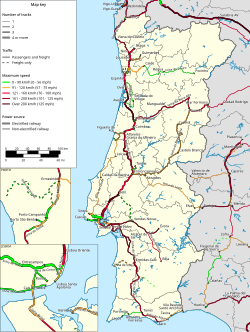 Map showing the railway lines in Portugal operated by CP in 2023. Map showing the railway lines in Portugal operated by CP in 2023. | |
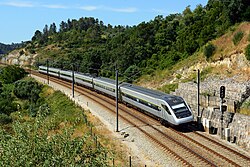 CP Alfa Pendular train in 2020. CP Alfa Pendular train in 2020. | |
| Technical | |
|---|---|
| Track gauge | 1,668 mm (5 ft 5+21⁄32 in) Iberian gauge and 1,000 mm (3 ft 3+3⁄8 in) metre gauge |
CP — Comboios de Portugal, EPE (European Portuguese: [kõˈbɔjuʒ ðɨ puɾtuˈɣal]; CP; English: Trains of Portugal) is a state-owned company which operates passenger trains in Portugal. Prior to June 2009, CP stood for Caminhos de Ferro Portugueses (English: Portuguese Railways) although the company has been using its current designation as a brand name since 2004.
CP can trace its origins back to October 1856 and the opening of the first railway line in Portugal; the majority of the network has long comprised Iberian gauge lines, compatible with neighboring Spain. During the 1950s, the Portuguese railway network spanned roughly 3,750 km (2,330 mi), its greatest extent. In 1975, the Portuguese Railway Company was nationalised. Amid a decline in passenger numbers, various lines were shut down, with almost a quarter of the rail network being closed by the twenty-first century.
During the 1990s, various efforts to restructure and improve CP services have been initiated. During 1999, CP introduced its new flagship service, the Alfa Pendular, which operates between Braga - Porto - Lisbon - Faro using tilting trains. Since 2005, management of the railway infrastructure has been split from CP, which instead focuses on train services, while the former role is now performed by Infraestruturas de Portugal (IP). Also, CP's cargo activities were transferred to private company MSC who operate them under the Medway label; leaving CP to only operate passenger trains. In 2015, a new long-term strategy for Portugal's railway network has been underway, under which full electrification of the network, the provision of European Rail Traffic Management System (ERTMS), and the general modernisation and improvement of trunk routes and international services is being conducted. Throughout early 2023, CP's operations have been repeatedly disrupted by industrial action.
History

On 28 October 1856, the first railway line in Portugal was inaugurated between Lisbon and Carregado; the event marked the origins of the Companhia dos Caminhos de Ferro Portugueses. While the early railways in Portugal had been constructed in standard gauge, subsequent lines were built to the Iberian gauge as to be compatible with neighboring Spain; the initial standard gauge tracks were also rebuilt into Iberian gauge for consistency.
The railway network was gradually expanded both south of the Tagus and to the north of the country, as well as in the metropolitan areas of Lisbon and Porto and to Spain. Portugal's railways would play a role in numerous significant national events. On 14 December 1910; President Sidonio Bernardino Cardeso da Silva Paes was assassinated at Lisboa-Rossio Railway Station of one of the presidents of the first republic. In 1958, a railway rout formed a prominent part of the political campaign of the democratic opposition candidate Humberto Delgado for the Portuguese presidency. More generally, the railways had been crucial to the rapid dissemination of news across the more rural areas of the nation.
It was during the 1950s that the Portuguese railway network expanded to its greatest extent, covering roughly 3,750 km (2,330 mi). Throughout the second half of the 20th century, the majority of CP's rolling stock was built in Portugal by Sorefame - notably carriages with stainless steel bodywork. Gradually, electrification was put in place for a little less than half the network. In 1975, the company was nationalised, after which its name was shortened to CP. During the 1970s and especially during the 1980s, as cars became increasingly affordable to average citizens, passenger demand on CP's network declined considerably, spurring decreases in investment, the cutting back on little-used services, and the closure of less trafficked lines. By the twenty-first century, almost a quarter of the rail network had been closed, around 2,630 km (1,630 mi) remained operational, while of the roughly 900 stations once active, only 563 remained in use by 2023.
During the 1990s, CP inaugurated new trains for its suburban service within Lisbon; during 2001, new rolling stock was brought into service on Porto's suburban services as well. In September 2012, the Portuguese government announced its intention to privatise portions of the suburban rail services of Liborn and Porto via a leasing arrangement. The move was part of a wider initiative towards increasing the liberalisation of the domestic Portuguese rail network.
During 1999, CP introduced its new flagship service, the Alfa Pendular, which operates between Braga - Porto - Lisbon - Faro. Using a fleet of FIAT/Siemens tilting trains, it has a maximum operating speed of 220 km/h (138 mph). Despite this, the majority of Portugal's lines were not suitable for high speed operations, which was a partial consequence of the protracted lack of investment. By 2006, CP's network covers the majority of the country.
Various changes to modernise and improve CP's railway network were proposed during the early twenty-first century. At the time, the infrastructure suffered from a lack of uniformity, particularly in respect to signalling and electrical supply systems, while freight services were subject to numerous restrictions even on heavily trafficked trunk lines. A programme of works to finally connect all the district capitals by a fully electrified double line was to be implemented from 2010; elements of this plan were based on the Swiss Rail 2000 model. Furthermore, the Portuguese government was keen to improve intermobility between the rail network and various other logistic platforms, such as airports and seaports, as well as to improve links with pan-European transportation mediums in general.
In 2015, a new long-term strategy for Portugal's railway network was announced; it called for the full electrification of the network, along with the provision of European Rail Traffic Management System (ERTMS) signaling and control apparatus, infrastructure compliance with the relevant European standards along all of the main freight corridors for complete interoperability, and changed to enable the running of 750 m (2,460 ft)-long trains carrying up to 1,400 tonnes of cargo. Particular attention was paid to the modernisation of those lines used by international services and trunk routes that traversed the country.
During 2019, CP transported 145 million passengers, an increase of 19 million from the previous year.
Throughout early 2023, CP's passenger services have been repeatedly disrupted by industrial action taken by its employees.
The Vouga line is presently the only narrow gauge line that remains operational.
Infrastructure
Main article: Infraestruturas de PortugalThe infrastructure of the Portuguese network is managed by Infraestruturas de Portugal, usually abbreviated to IP
Portuguese railway network extent:
- Broad gauge (1,668 mm (5 ft 5+21⁄32 in)): 2,603 km (1,617 mi), 1,351 km (839 mi) electrified at 25 kV 50 Hz AC and 25 km (16 mi) at 1.5 kV DC.
- Narrow gauge (metre gauge) 1,000 mm (3 ft 3+3⁄8 in): 188 km (117 mi) not electrified.
- The maximum extent of 3,592 km (2,232 mi) was reached in 1949, but in the late 1980s and early 1990s some lines were shortened and some totally closed.
Organisation


CP is split into three divisions:
- CP Longo Curso, long-distance mainline services (Alfa Pendular, Intercidades and International trains).
- CP Regional, regional services (Interregional and Regional).
- CP Urban Services
Services
CP offers the following types of trains:
- International (IN) is the service that connects Portugal with Spain called Celta (Porto-Vigo). The Sud-Express (Lisbon-Hendaye) and Lusitânia (Lisbon-Madrid) ran to both Spain and France under Renfe's Trenhotel (Hotel Train) brand until it was discontinued in 2020
- Alfa Pendular (AP) is the fastest service, whose speeds can reach 220 km/h. This service runs from Lisbon to either Porto, Braga or Guimarães (passing through Coimbra, Aveiro and Porto) or between Porto and Faro.
- Intercidades (IC) is a fast long-distance service whose speeds can reach 200 km/h. All IC services (apart from the Beja Shuttle) run from Lisbon to either Porto, Braga, Guimarães, Guarda, Covilhã or Évora (with connection at Casa Branca to Beja), serving the majority of the Portuguese regions. Service to southern Portugal runs to cities including Tunes, Faro, and Albufeira.
- Inter-Regional (IR) is a medium distance service which stops only at the main stations. Runs mainly on the routes Porto-Viana do Castelo-Valença (Minho Line), Porto-Régua-Pocinho (Douro Line), Lisbon-Caldas da Rainha-Leiria-Coimbra (West Line) and Lisbon-Tomar (North Line). Services are operated by the same trains as Regional service.
- Regional (R) is CP's local service, stopping at all stations, out of the Lisbon and Porto suburban areas.
- Urbano (U) is the CP's urban service, in the regions of Lisbon and Porto and in the Coimbra-Figueira da Foz Line.
Lines/Routes
The lines are no longer maintained by CP, due to EU regulations, so the infrastructure is now handled by the public company Infraestruturas de Portugal.
| Line | Gauge | Status | Notes |
|---|---|---|---|
| Alentejo | Iberian | Partially Opened | No traffic between Beja and Ourique and freight only between Ourique and Funcheira |
| Alfarelos Branch | Iberian | current | |
| Algarve | Iberian | current | |
| Beira Alta | Iberian | current | Closed from April 2022 for a complete overhaul. Scheduled to reopen by the end of 2024 |
| Beira Baixa | Iberian | current | |
| Ramal de Braga | Iberian | current | |
| Ramal de Cáceres | Iberian | former | closed in 2012 |
| Cascais | Iberian | current | |
| Cintura | Iberian | current | |
| Corgo | metre | former | closed in 1990 between Vila Real and Chaves; remaining section closed in 2009 |
| Dão | metre | former | closed in 1989 |
| Douro | Iberian | Partially Opened | closed in 1988 between Pocinho and Barca d'Alva |
| Ramal do Estádio Nacional | Iberian | former | closed in 1979 |
| Évora | Iberian | current | closed in 1990 between Estremoz and Vila Viçosa; closed in 2009 between Évora and Estremoz |
| Évora–Elvas | Iberian | future | New line between Évora and Elvas (not a high speed line) |
| Ramal da Figueira da Foz | Iberian | former | closed in 2009 |
| Guimarães | metre | former | closed in 1986 between Guimarães and Fafe; closed in 2001 between ISMAI and Trofa; converted to Iberian gauge between Trofa and Guimarães in 2004; converted to Porto Metro between Senhora da Hora and ISMAI in 2005 |
| Guimarães | Iberian | current | |
| Linha de Leixões | Iberian | current | freight only |
| Leste | Iberian | current | passenger service restored in 2017 |
| Lisbon–Porto HSL | Iberian | future | |
| Ramal do Louriçal | Iberian | current | freight only |
| Ramal da Lousã | Iberian | former | closed in 2010 for construction of Metro Mondego; work halted due to lack of funds |
| Matinha | Iberian | Partialy Opened | Closed between Sacavém and Beato in the mid 1990's to make way for Expo '98 grounds
freight only |
| Minho | Iberian | Partialy Opened | Closed in 1990 between Valença and Monção |
| Montemor | Iberian | former | closed in 1989 |
| Montijo | Iberian | former | closed in 1989 |
| Mora | Iberian | former | closed in 1990 |
| Moura | Iberian | former | closed in 1990 |
| Norte | Iberian | current | |
| Oeste | Iberian | current | |
| Portalegre | Iberian | former | closed in 1990 |
| Póvoa | metre | former | Closed in 1995 between Póvoa de Varzim and Famalicão
Porto (Trindade) - Póvoa de Varzim converted to Porto Metro between 2002 and 2006 |
| Porto-Vigo HSL | Iberian | future | |
| Ramal Neves Corvo | Iberian | current | freight only |
| Sabor | metre | former | closed in 1988 |
| Sines | Iberian | current | freight only |
| Sintra | Iberian | current | |
| Sul | Iberian | current | |
| Tâmega | metre | former | Closed in stages between 1990 and 2009: Arco de Baúlhe - Amarante (1990) and Amarante - Livração (2009). |
| Ramal de Tomar | Iberian | current | |
| Tua | metre | former | Closed in stages between 1992 and 2019: Bragança - Mirandela (1992), Tua - Cachão (2008) and Cachão - Mirandela - Carvalhais (2019). Mirandela - Carvalhais section reopened between 1995 and 2019 as Metro de Mirandela |
| Vendas Novas | Iberian | current | freight only |
| Vouga | metre | Partialy Opened | Viseu branch closed in 1990 |
Current Rolling Stock
Locomotives
| Image | Class (Nickname) | In Service
since |
Numbers | Traction | Gauge | Max Speed | Services | |
|---|---|---|---|---|---|---|---|---|
| In Service | Total | |||||||

|
0180 | 1924 | 1 | 2 | Steam | Iberian | Seasonal
Heritage | |
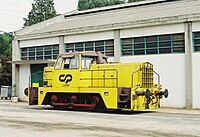
|
1150 (Sentinel) | 1967 | 4 | 36 | Diesel | Iberian 1668mm | 56 km/h | Workshop
Shunting |

|
1400
(English Electric) |
1967 | 11 | 67 | Diesel | Iberian | 105 km/h | InterRegional
Shunting Breakdown Train |

|
1550 (MLW) | 1973 | 3 | 20 | Diesel | Iberian | 120 km/h | Breakdown Train |

|
2600 (Alstom) | 1974 | 9 | 12 | Electric | Iberian | 160 km/h | InterRegional
InterCidades* |

|
2620 (Alstom) | 1987 | 3 | 9 | Electric | Iberian | 160 km/h | InterRegional
InterCidades* |

|
5600 | 1993 | 19 | 24 | Electric | Iberian | 220 km/h | InterCidades |

|
E200 | 1911 - 1923 | 1 | 6 | Steam | Meter | 50 km/h | Seasonal
Heritage |

|
9000 | 1975 | 1 | 3 | Diesel | Meter | 70 km/h | Seasonal
Heritage |
| (*): Only in case of a CP 5600 failure | ||||||||
Multiple Units
| Image | Class | Type | In Service
since |
Built in | Numbers | Traction | Gauge | Max Operational
Speed |
Services | |
|---|---|---|---|---|---|---|---|---|---|---|
| In Service | Total | |||||||||

|
0350 (Allan) | 1 Car DMU | 2000 | 2000 | 5 | 18 | Diesel | Iberian | 100 km/h | Regional |

|
0450 (UDD) | 2 Car DMU | 1998 | 1998 | 19 | 19 | Diesel | Iberian | 120 km/h | Regional
InterRegional |

|
592
(Camelas) |
3 Car DMU | 2011 | 1984
(Refurbished in 2001) |
20 | 24 | Diesel | Iberian | 140 km/h | Regional
InterRegional International (Celta) |

|
9630 | 2 Car DMU | 1991 | 1991 | 7 | 7 | Diesel | Meter | 90 km/h | Regional |

|
2240 | 3 Car EMU | 2004 | 2003 | 55 | 55 | Electric | Iberian | 120 km/h | Urban
Regional InterRegional |

|
2300 | 4 Car EMU | 1992 | 1992 | 42 | 42 | Electric | Iberian | 120 km/h | Urban |

|
2400 | 4 Car EMU | 1997 | 1997 | 14 | 14 | Electric | Iberian | 120 km/h | Urban |
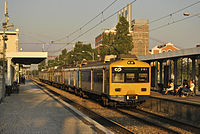
|
3150 | 3 Car EMU | 1998 | 1998 | 13 | 13 | Electric | Iberian | 90 km/h | Urban |
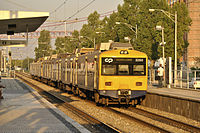
|
3250 | 4 Car EMU | 1998 | 1998 | 18 | 21 | Electric | Iberian | 90 km/h | Urban |

|
3400 | 4 Car EMU | 2002 | 2002 | 34 | 34 | Electric | Iberian | 140 km/h | Urban |

|
3500 | 4 Car 2-floor EMU | 1999 | 1999 | 12 | 12 | Electric | Iberian | 140 km/h | Urban |

|
4000 | 6 Car
High Speed EMU |
1999 (Refurbished
in 2017) |
1998 | 9 | 10 | Electric | Iberian | 220 km/h | Alfa Pendular |
Passenger Cars
| Image | Name | In Service
since |
Numbers | Gauge | Max Speed | Services | Notes | |
|---|---|---|---|---|---|---|---|---|
| In Service | Total | |||||||
| Stainless Steel Cars with A/C | ||||||||

|
Corail | 1985 | 58 | 58 | Iberian | 200 km/h
(originally 160) |
InterCidades | Modernized over
the years, first used on the now-extinct "Alfa service" |

|
Sorefame
Modernizada |
1993-1996 | 45 | 45 | Iberian | 200 km/h | InterCidades | Modernized for
IC services |
| Mild Steel Cars with A/C | ||||||||

|
Arco | 2021 | 17 | 36 | Iberian | 200 km/h | InterRegional | Purchased
from Renfe in 2020. |

|
9000 | N/A | 0 | 4 | Iberian | 160 km/h | Not in Service | Purchased
from Renfe in 2020 |

|
Gran Confort | N/A | 0 | 5 | Iberian | 160 km/h | Not in Service | Purchased
from Renfe in 2020 |

|
Corail | N/A | 0 | 5 | Iberian | 160 km/h | Not in Service | Purchased
from Renfe in 2020 |
| Stainless Steel Cars without A/C | ||||||||

|
Sorefame
Classic |
1963-1984 | 9 | 74 | Iberian | 140 km/h | Regional
InterRegional |
Most withdrawn
from service or modernized for IC services |
| Mild Steel Cars without A/C | ||||||||

|
Schindler | 1948–1949 | 17 | 19 | Iberian | 120 km/h | Regional
InterRegional |
Out of service
between 1996 and 2017. Refurbished from 2017 to 2021 |
| Napolitanas | 1931 | 1 | 5 | Meter | Seasonal
Heritage |
Used on the
Vouga Historic Steam Train | ||
-
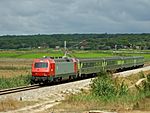 CP's 5600 Series (19 units) are responsible for all Intercity services. Four sold and five leased to Medway for freight use. One is here seen on the Linha do Sul, near Alcácer do Sal.
CP's 5600 Series (19 units) are responsible for all Intercity services. Four sold and five leased to Medway for freight use. One is here seen on the Linha do Sul, near Alcácer do Sal.
-
 CP's 4000 Series work all Alfa Pendular services. Here on is seen at Entroncamento on the Linha do Norte.
CP's 4000 Series work all Alfa Pendular services. Here on is seen at Entroncamento on the Linha do Norte.
-
 CP's 2240 Series are responsible for Urban (Lisbon's Sado Line and the Coimbra to Figueira da Foz urban service), Regional and Inter-Regional services. Unit 2295 is here seen with a now outdated red color scheme, on the Linha do Norte, near Entroncamento.
CP's 2240 Series are responsible for Urban (Lisbon's Sado Line and the Coimbra to Figueira da Foz urban service), Regional and Inter-Regional services. Unit 2295 is here seen with a now outdated red color scheme, on the Linha do Norte, near Entroncamento.
-
 Most of Lisbon's suburban trains (except the Cascais Line services), are in the hands of CP's 2300/2400 Series. Two are here seen on the Linha do Norte, near Santa Iria de Azoia.
Most of Lisbon's suburban trains (except the Cascais Line services), are in the hands of CP's 2300/2400 Series. Two are here seen on the Linha do Norte, near Santa Iria de Azoia.
-
 All Linha de Cascais urban trains are in the hands of CP's 3150/3250 Series.Two are here seen near Cruz Quebrada.
All Linha de Cascais urban trains are in the hands of CP's 3150/3250 Series.Two are here seen near Cruz Quebrada.
-
 CP's 3400 are responsible for all Porto urban services. One is here seen at São Bento station.
CP's 3400 are responsible for all Porto urban services. One is here seen at São Bento station.
-
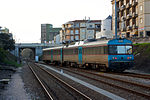 CP's 0450 Series are responsible for some Regional and Inter-Regional services. They are also in charge of the Intercity shuttle service between Casa Branca and Beja. One is here seen at Caldas da Rainha.
CP's 0450 Series are responsible for some Regional and Inter-Regional services. They are also in charge of the Intercity shuttle service between Casa Branca and Beja. One is here seen at Caldas da Rainha.
-
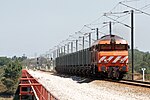 CP's 1900/1930 Series were responsible for passenger (1930 only) and freight (both) services. Several sold to Medway and Ferrocentral (Argentina). All of CP units have been withdrawn from service.
CP's 1900/1930 Series were responsible for passenger (1930 only) and freight (both) services. Several sold to Medway and Ferrocentral (Argentina). All of CP units have been withdrawn from service.
-
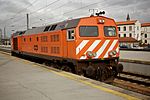 CP's 1960 Series were the most powerful diesel locos in Portugal. They hauled both passenger (until the Beira Alta Line was electrified) and freight trains. Some sold to Medway. All of CP units have been withdrawn from service. One is here seen at Porto Campanhã.
CP's 1960 Series were the most powerful diesel locos in Portugal. They hauled both passenger (until the Beira Alta Line was electrified) and freight trains. Some sold to Medway. All of CP units have been withdrawn from service. One is here seen at Porto Campanhã.
-
 CP's 0350 Series were once mainly used for Regional on unelectrified rural lines. As of 2021 only 3 remain in service. One is here seen at Guarda.
CP's 0350 Series were once mainly used for Regional on unelectrified rural lines. As of 2021 only 3 remain in service. One is here seen at Guarda.
-
 CP's 4700 Series were the backbone of their freight business. All 25 units were sold to Medway.
CP's 4700 Series were the backbone of their freight business. All 25 units were sold to Medway.
Major stations
See also: List of railway stations in PortugalLisbon
- Cais do Sodré - for local trains from Lisbon to Cascais. Portugal's busiest interchange station (train/ferry/metro/tram/bus)
- Oriente - for trains to the north and to the Algarve
- Rossio - for local trains to Sintra
- Santa Apolónia - terminus station, for trains to the north and to Spain
Porto
- Campanhã - Porto's main station, including use by Alfa Pendular high speed trains
- São Bento - city centre terminus, for local services, northbound and Douro line trains
Other
Accidents and Incidents
On 21 January 2013, two trains crashed on the Portuguese Northern Line in Alfarelos. 25 people were injured and the line was closed for three days.
On 31 July 2020, an Alfa Pendular Train collided with a track maintenance vehicle at Soure, Portugal. Two people were killed and 43 were injured, three seriously.
See also
- History of rail transport in Portugal
- Iberian gauge
- Narrow gauge railways in Portugal
- National Railway Museum (Portugal)
- Rail transport in Portugal
- High-speed rail in Portugal
References
- Martins, João Paulo; Brion, Madalena; Sousa, Miguel de; Levy, Maurício; Amorim, Óscar (1996). O Caminho de Ferro Revisitado: O Caminho de Ferro em Portugal de 1856 a 1996. Caminhos de Ferro Portugueses. p. 446.
- ^ Comboios de Portugal (2018). "Relatório & Contas Consolidado" (PDF) (in Portuguese).
- ^ "The Portuguese Railway: 160 years and 160 more". globalrailwayreview.com. 14 December 2016.
- "Under the Eucalyptus Trees – TIME". Time. 14 May 1965. Archived from the original on 1 May 2009. Retrieved 25 December 2007.
- "Bus often faster than rail in Portugal, analysis shows". railtech.com. 14 February 2023.
- "CP – an attractive transport brand with a clear future focus". globalrailwayreview.com. 19 September 2012.
- "Portuguese Trains Unveil Refurbished Alfa Pendular". railway-news.com. 27 March 2017.
- "CP route map" (PDF). Archived from the original (PDF) on 20 May 2011.
- Stohler, Werner. "Modernização do sistema da exploração ferroviária da Região de Coimbra" (PDF) (in Portuguese). Archived from the original (PDF) on 11 August 2011. Retrieved 7 November 2010.
- "Portugal – plans, projects and priorities". globalrailwayreview.com. 28 July 2006.
- "The strategy for Portuguese railways 2014-2050". globalrailwayreview.com. 1 October 2015.
- "Atlantic Corridor: More capacity, higher performance, better information". globalrailwayreview.com. 31 January 2017.
- "A Empresa | CP - Comboios de Portugal".
- "Passageiros e receitas da CP aumentam em 2019". Sol. 8 March 2020. Retrieved 9 March 2020.
- "Rail strike continues". theportugalnews.com. 15 February 2023.
- "Which trains will be running during the strike today?". theportugalnews.com. 3 April 2023.
- Nuevo, Mar; Fernández, Alejandro (2021-03-12). "Estos son los últimos destinos de los trenes nocturnos en España". Business Insider España (in Spanish). Retrieved 2024-06-15.
- See the timetable at www.cp.pt
- "Linha do Leste - Comboios Regionais 5500 e 5501| CP". Archived from the original on 2017-08-31. Retrieved 2017-08-31.
External links
| National railway companies of Europe | |
|---|---|
| |
|